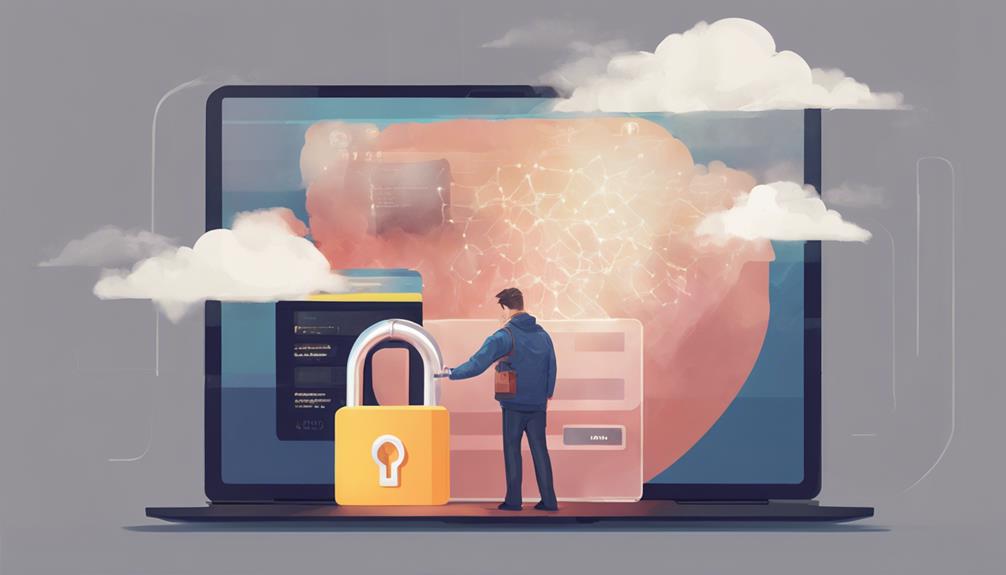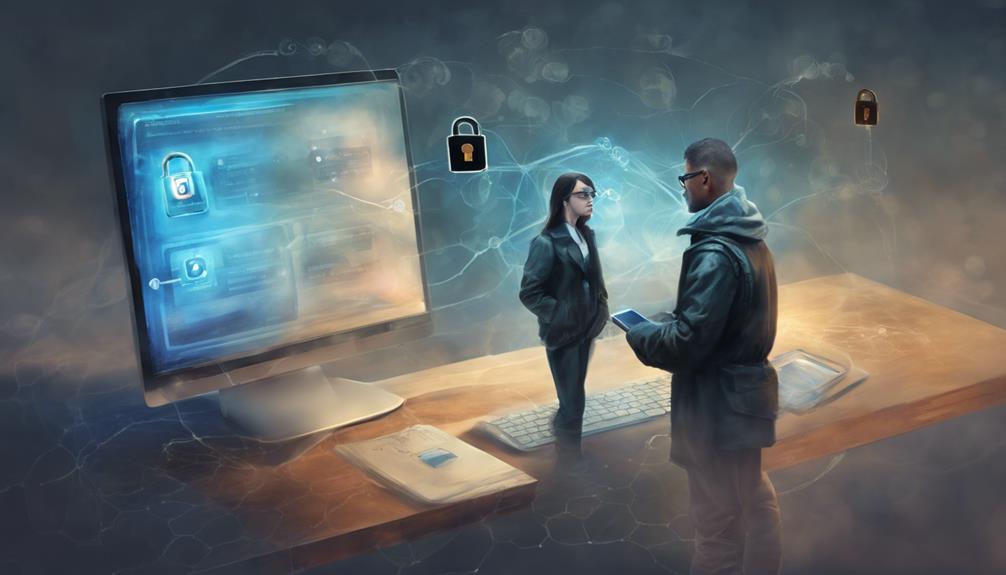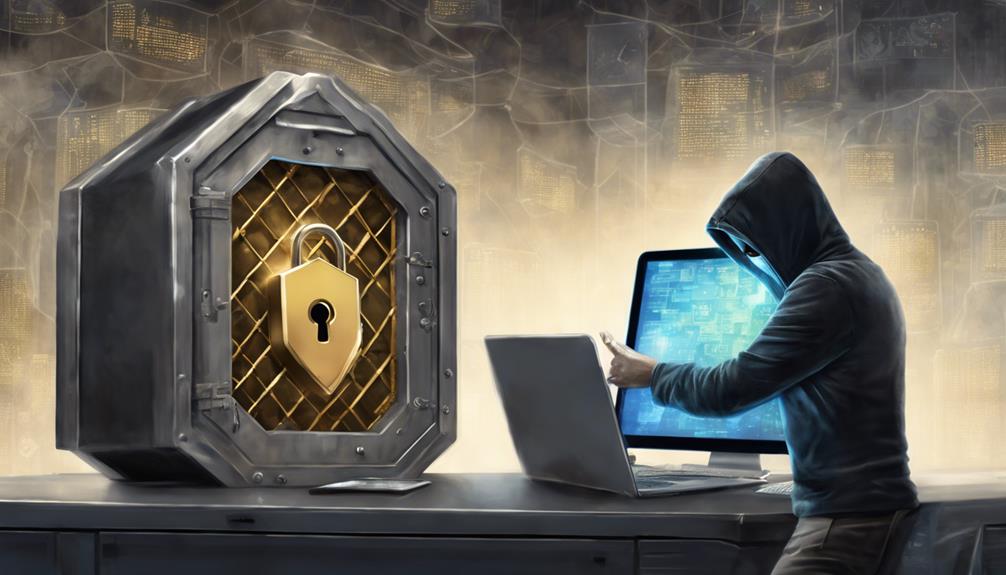Onedrive is committed to employing advanced encryption methods like AES 256-bit encryption, two-factor authentication, access controls, and regular security updates to protect against hacker threats. Its robust encryption protocols, alongside two-factor authentication mechanisms and access controls, enhance data security. The platform's focus on implementing regular security updates further fortifies its defenses against potential vulnerabilities, malware threats, and data theft risks. By prioritizing security measures such as these, Onedrive aims to provide a secure environment for user data. Understanding these protective measures is crucial for users concerned about the platform's security against hackers.
Key Takeaways
- Onedrive employs AES 256-bit encryption for data security.
- Two-factor authentication adds an extra layer of protection.
- Regular security updates enhance defense against hackers.
- Access controls and encryption keys prevent data breaches.
- Vulnerabilities like weak passwords are mitigated with strong security measures.
Onedrive Security Measures
OneDrive's security measures are robust, incorporating advanced encryption methods and additional layers of protection to safeguard user data from potential cyber threats. Microsoft, the provider of OneDrive cloud storage, employs AES 256-bit encryption for uploads, downloads, and backups, guaranteeing that data remains secure both in transit and at rest. This level of encryption is considered highly secure and is widely used to safeguard sensitive information.
In addition to encryption, OneDrive offers two-factor authentication, adding an extra layer of security by requiring users to provide a second form of verification before accessing their accounts. Access controls are also in place to manage permissions and ensure that only authorized individuals can view or modify data.
While these security measures enhance data protection and privacy, it is essential to note that Microsoft and certain third parties may have access to data under specific circumstances, potentially impacting the confidentiality of stored information.
Two-Factor Authentication Implementation

Implementing Two-Factor Authentication (2FA) on OneDrive accounts is vital in bolstering security measures.
By requiring a second form of verification, such as a code from the Microsoft Authenticator app, 2FA adds an extra layer of protection against unauthorized access attempts.
Enhancing account security with 2FA not only prevents hacking incidents but also safeguards sensitive data stored on OneDrive from potential breaches.
Two-Factor Authentication Basics
Enhancing account security, two-factor authentication requires a secondary form of verification in addition to a password, providing an extra layer of security against unauthorized access. By requiring a second factor to prove your identity, even if a hacker manages to obtain your password, they would still need the additional verification to access your account.
Common methods used for two-factor authentication include SMS codes sent to your phone, authenticator apps generating time-sensitive codes, and biometric verification like fingerprint or facial recognition. Implementing two-factor authentication on platforms like Onedrive is highly recommended by cybersecurity experts to mitigate potential hacking attempts.
This additional security measure reduces the risk of unauthorized entry into your account, ensuring that only authorized individuals with the necessary verification can access sensitive information stored on Onedrive, safeguarding your data from cyber threats.
Benefits of 2FA
The utilization of two-factor authentication (2FA) on OneDrive offers enhanced security benefits by adding an extra layer of verification beyond traditional password protection. By requiring a second form of verification, such as a code sent to a mobile device or generated by an authentication app, 2FA greatly reduces the risk of unauthorized access to sensitive data stored on OneDrive.
Implementing 2FA on a Microsoft account linked to OneDrive is a recommended security measure to safeguard personal and business data from hackers. This extra layer of security helps protect against potential breaches even if passwords are compromised. With 2FA in place, users can deter unauthorized access attempts and enhance the overall security of their accounts.
It is important to prioritize the implementation of two-factor authentication to fortify the protection of valuable information stored on OneDrive.
Enhancing Account Security
Securing your OneDrive account with two-factor authentication greatly enhances protection against unauthorized access. Two-factor authentication adds an extra layer of security by requiring a second verification step, reducing the risk of unauthorized access to your data. This security measure verifies the identity of users through a secondary method, such as the Microsoft Authenticator app, ensuring enhanced account security and identity verification. Implementing two-factor authentication is a recommended practice to safeguard your OneDrive account from potential hackers.
| Security Measure | Description | Benefits |
|---|---|---|
| Two-factor authentication | Requires a second verification step for accessing your account | Enhances account security |
| Microsoft Authenticator | App used for the secondary method of identity verification | Adds an extra layer of security |
| Identity verification | Confirms that only authorized users can access the account | Reduces the risk of unauthorized access |
Data Encryption Protocols

OneDrive employs essential data encryption protocols, utilizing AES 256-bit encryption for data protection at rest and in transit.
Microsoft manages encryption keys, enhancing security measures, and TLS encryption adds an extra layer of protection during data transfer.
These encryption methods play a vital role in preventing data breaches and ensuring the security of user information stored on OneDrive.
Encryption Methods Overview
Utilizing advanced encryption protocols is paramount for safeguarding sensitive data stored on cloud services like OneDrive. The encryption methods employed by OneDrive, particularly the AES 256-bit standard, play an essential role in guaranteeing data security against potential threats from hackers.
Here is an overview of the encryption methods used by OneDrive:
- AES 256-bit standard: OneDrive utilizes this highly secure encryption standard to protect data from unauthorized access.
- Encryption keys: Microsoft manages encryption keys to uphold data security and prevent breaches.
- TLS encryption: Secure data transfer is guaranteed through TLS encryption, which prevents interception by malicious actors.
- Data protection: Strong encryption methods like AES 256-bit make it challenging for hackers to compromise the security of OneDrive.
Incorporating these encryption standards and practices enhances OneDrive's security measures, making it a reliable platform for storing sensitive information securely.
Security Key Importance
Enhancing data security on cloud storage platforms requires a robust focus on the importance of security keys and data encryption protocols. OneDrive employs AES 256-bit encryption, a robust standard for secure data storage and transmission.
However, the management of encryption keys by Microsoft raises concerns about potential vulnerabilities if these keys are compromised by unauthorized entities. Additionally, the absence of zero-knowledge encryption means that Microsoft retains the ability to access user data when necessary, which could pose a risk to data security and privacy.
To counter these risks, users can enhance their data protection by utilizing additional security measures such as two-factor authentication and personal vaults. Two-factor authentication provides an extra layer of security against unauthorized access, while personal vaults offer a more secure storage space for sensitive information.
Data Breach Prevention
Implementing robust data encryption protocols is vital for preventing data breaches on cloud storage platforms like OneDrive. Microsoft's employment of AES 256-bit encryption for data protection guarantees that information is secure both at rest and in transit, mitigating security risks associated with unauthorized access.
The encryption keys managed by Microsoft add an extra layer of protection, making it difficult for hackers to breach the system. Additionally, enabling two-factor authentication further strengthens security by requiring an additional verification step for users, enhancing the safeguard against unauthorized access attempts.
Continuous security monitoring and virus scanning mechanisms on OneDrive play an important role in detecting and thwarting potential hacking endeavors. By combining encryption and two-factor authentication with stringent security tools and protocols, you can effectively protect your data from potential breaches and maintain the integrity of your information stored on OneDrive.
Vulnerabilities and Weaknesses

Weaknesses and vulnerabilities in OneDrive's security measures can expose users to potential hacking risks and unauthorized access to their accounts. One common risk is the use of weak passwords, which can be easily exploited by hackers. Compromised credentials, whether through phishing attacks or other means, can also lead to unauthorized access to OneDrive accounts, compromising the user's data privacy.
Malware infections on devices synced with OneDrive pose another vulnerability, as they can potentially compromise the data stored on the cloud service. The absence of two-factor authentication further heightens the risk of unauthorized access by malicious actors.
Social engineering tactics, such as manipulating users into divulging sensitive information, are also a concern for Onedrive account privacy and security. To address these risks, users should be vigilant against phishing attempts, adopt strong password practices, regularly scan for malware, and consider enabling two-factor authentication to enhance their account security.
Malware Threats and Prevention

The essential implementation of advanced malware detection systems on OneDrive safeguards users' data from potential security threats. Microsoft OneDrive employs robust virus and ransomware detection mechanisms to guarantee the secure storage of files on the cloud service.
To enhance security, users can enable features like personal vault and two-factor authentication in their OneDrive security settings. Additionally, regular software updates and the practice of using strong passwords play a vital role in preventing malware threats from infiltrating the cloud storage platform.
Data stored on OneDrive is encrypted both at rest and in transit using AES 256-bit encryption, making it challenging for hackers to gain unauthorized access to sensitive information. By continually updating security measures and educating users on best practices, Microsoft aims to provide a secure environment for data storage and access on OneDrive.
Access Control Best Practices

To fortify the security of data stored on OneDrive, implementing access control best practices is essential to prevent unauthorized access and safeguard sensitive information. Strong password policies are key in thwarting potential hackers from gaining entry into accounts.
Additionally, incorporating two-factor authentication adds an extra layer of security, making it more important for unauthorized individuals to breach the system.
Regularly reviewing and updating access controls is critical to make sure that only authorized personnel have access to sensitive data, reducing the risk of security breaches.
Educating users on secure access practices further minimizes the chances of unauthorized access to OneDrive accounts.
Monitoring and logging access to OneDrive is important in detecting any suspicious activity that may signal a potential security breach, allowing for swift action to be taken to address any security concerns.
Data Theft Risks and Solutions

Mitigating the risks of data theft on OneDrive requires robust security measures and proactive solutions to safeguard sensitive information from unauthorized access. Cloud storage providers like OneDrive must prioritize data security and privacy to protect users' valuable information. To achieve this, they can implement the following key strategies:
- Enforcing strong password policies: Require users to create complex passwords and regularly update them to prevent unauthorized access.
- Implementing Two-factor authentication: Provide an additional layer of security by requiring users to verify their identity through a second method, such as a mobile device.
- Adopting Data Loss Prevention policies: Establish rules and protocols to prevent accidental data leaks and unauthorized access to sensitive information.
- Conducting employee cybersecurity training: Educate staff members about the importance of data security, phishing attempts, and social engineering tactics used by hackers to enhance overall awareness and vigilance.
Regular Security Updates Importance

Enforcing regular security updates in OneDrive is imperative to proactively address vulnerabilities and enhance protection against emerging hacker threats. Timely updates play a crucial role in patching vulnerabilities and safeguarding against hacker exploits and security breaches. By continuously monitoring security measures and promptly updating the system, OneDrive strengthens its defense mechanism and fortifies its system security. Neglecting to update regularly exposes OneDrive to potential security weaknesses that hackers may exploit, putting sensitive data at risk.
| Importance of Regular Security Updates | ||
|---|---|---|
| Patch Vulnerabilities | Protect Against Hackers | Enhance System Security |
| Address Security Weaknesses | Strengthen Defense Mechanism | Monitor Security Measures |
| Safeguard Data | Prevent Security Breaches |
Frequently Asked Questions
Can Hackers Access Onedrive Files?
Hackers may attempt to access OneDrive files through various means, but robust security measures such as AES 256-bit encryption, two-factor authentication, virus detection systems, regular audits, and encryption key management by Microsoft greatly reduce the risk of unauthorized access.
What Are the Downsides of Onedrive?
What are the downsides of Onedrive? While Onedrive offers convenient cloud storage, concerns include privacy risks due to access by third-parties, limited storage space, bandwidth restrictions, and potential syncing issues. Is the convenience worth the trade-offs?
Should I Use Onedrive or Not?
When deciding whether to use OneDrive, consider its robust security measures like AES 256-bit encryption, two-factor authentication, regular security audits by Microsoft, data breach prevention systems, and the importance of implementing strong password protocols for enhanced data protection.
Can Anyone See My Onedrive Files?
Access to Onedrive files is controlled by users, determining who can view, edit, or download them. Microsoft employs strong encryption and two-factor authentication for added security. Regular updates and password policies further safeguard against unauthorized access.
Conclusion
In summary, while Onedrive has implemented various security measures such as two-factor authentication and data encryption protocols, it is important to remain vigilant against potential vulnerabilities and malware threats.
Access control best practices and regular security updates are vital in mitigating data theft risks.
By staying informed and proactive in safeguarding sensitive information, users can help enhance the overall security of their data on Onedrive.









